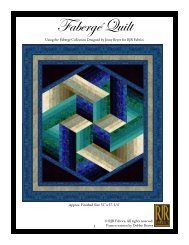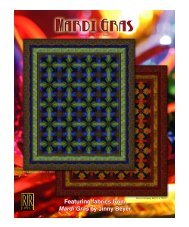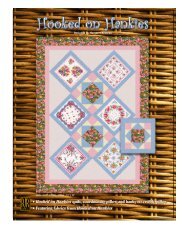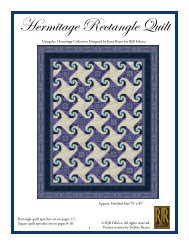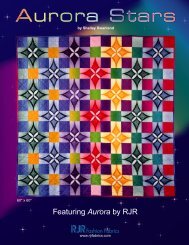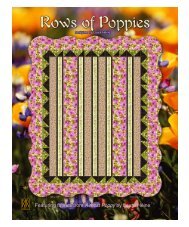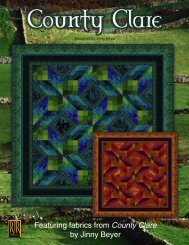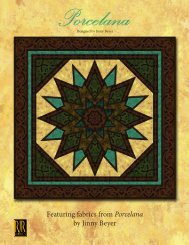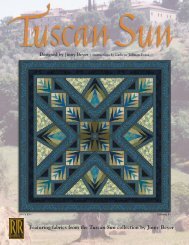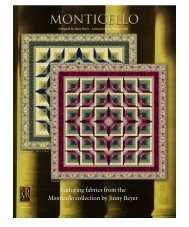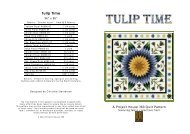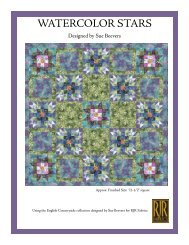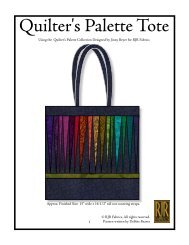Ashford - RJR Fabrics
Ashford - RJR Fabrics
Ashford - RJR Fabrics
Create successful ePaper yourself
Turn your PDF publications into a flip-book with our unique Google optimized e-Paper software.
Finishes 49" x 66"
Jinny puts a spin on the traditional log cabin block to create this marvelous new lap-size quilt. <strong>Ashford</strong> is foundation<br />
pieced to put the quilt within reach of quilters of all abilities — no tricky templates or fussy construction techniques to<br />
worry about. The magic is in the block rotation and Jinny’s masterful fabric shading. Quilt finishes 49" x 66".<br />
Read the entire pattern before beginning. All seam<br />
allowances are ¼". Pattern assumes basic foundation<br />
piecing and quiltmaking knowledge. WOF = width of<br />
fabric (estimated at 42 useable inches).<br />
Step 1: Copy Foundation Masters<br />
Eight A foundations and eight B foundations are<br />
required. Make a copy of pages 3-6, then tape the<br />
two halves of the corresponding foundation masters<br />
together along the dashed line. The foundations measure<br />
8½" x 12½" (outer dotted line). They can be<br />
reproduced on legal-sized paper (8½" x 14")<br />
although only the top and bottom portions of the<br />
outer dotted square will print. Trim the 16 paper<br />
foundations to the finished 8½" x 12½" size.<br />
Step 2: Cut <strong>Fabrics</strong><br />
For best use of fabric, the fabrics in the blocks are<br />
pre-cut to size. Cut the number/size of pieces noted on<br />
page 7 and keep them sorted in fabric number order.<br />
Fabric 14 (Border Print): From both the narrow and wide<br />
border stripes, cut the following. Be sure to include ¼-inch<br />
of seam allowance fabric on the long sides of each strip. (A<br />
solid stripe of fabric measuring at least ½-inch wide separates<br />
each design stripe; this is used for seam allowances.)<br />
• 2 strips measuring 63" (top/bottom borders)<br />
• 4 strips measuring 44" (side borders)<br />
(For the printed design to flow smoothly around the quilt,<br />
the side borders must be pieced; thus 4 strips ar required.)<br />
Step 3: Sew the Foundations<br />
The numbers printed on the foundations indicate the fabric<br />
number, not the piecing order. Pin a Fabric 6 patch in the<br />
center of the foundation and trim the fabric ¼-inch beyond<br />
the printed lines on the foundation. Trimming each patch<br />
¼-inch beyond the sewing line before adding the next<br />
patch is important to ensure that the pre-cut fabric<br />
strips are big enough.<br />
Add a Fabric 1 strip to the position marked with an asterisk<br />
(*). After sewing, pressing and trimming each strip, add the<br />
next one in clockwise order.<br />
After completing a foundation, trim the outside edge of the<br />
fabric and foundation along the outer dotted line and the<br />
sides of the paper foundation. Do not remove the paper.<br />
Block A<br />
Block B<br />
Step 4: Assemble the Quilt<br />
Referring to the Quilt Assembly diagram on the next page,<br />
and noting the order of the blocks, sew the blocks together<br />
in rows, then sew the rows together.<br />
Step 5: Make & Add the Borders<br />
Middle Border: Sew the reserved Fabric 1 strips together end<br />
to end, then cut:<br />
• two strips measuring 55" (top/bottom)<br />
• two strips measuring 65" (sides)<br />
Add the borders to the quilt, following the instructions for a<br />
rectangular quilt and Adding Multiple Borders in<br />
Framing a Quilt the Jinny Beyer Way. Remove the foundation<br />
papers from the blocks.<br />
For a video demonstration of the technique, visit<br />
www.jinnybeyer.com/bordertips.<br />
Step 7: Quilt & Bind<br />
Layer the quilt as follows: backing (wrong side up), batting,<br />
quilt top (right side up). Baste layers together. Quilt as<br />
desired.<br />
When quilting is completed, trim backing and batting even<br />
with edges of quilt top. Make binding strips using reserved<br />
fabric and bind using your favorite binding method or by following<br />
the instructions at<br />
www.jinnybeyer.com/promos/binding.<br />
1
A B A B<br />
Quilt Assembly: Sew the blocks together in rows, alternating<br />
the A and B blocks as illustrated. Sew the rows<br />
together.<br />
B A B<br />
A<br />
Template Size Check<br />
This box should measure<br />
2 inches square.<br />
If the box does not measure 2",<br />
the foundations will not be the<br />
correct size.<br />
A B A B<br />
If you are printing at home, be<br />
sure your printer is set to print at<br />
100% with no scaling.<br />
B A B<br />
A<br />
Jinny Beyer’s <strong>Ashford</strong> quilt is available with an alternative border option.<br />
There are no changes to the the fabrics used in the quilt blocks or to<br />
the construction method.<br />
Note the following changes on Page 7, then follow the pattern instructions<br />
as written.<br />
Fabric/Cutting Changes<br />
Fabric 1 is used only in the blocks; 3/8 yard required. Do not cut the<br />
strips noted for the middle border.<br />
Fabric 8 is used for the middle border in addition to the blocks and<br />
binding; 1¼ yards required. First cut 6 strips measuring 2¼" x WOF<br />
for the middle border, then cut the fabric as noted on the pattern.<br />
Fabric 14 is fabric style number<br />
1695-02 (pictured, right).<br />
<strong>Ashford</strong> Quilt<br />
Fabric Changes (Blue Border)<br />
2
<strong>Ashford</strong> Block A - JINNY BEYER STUDIO TOP<br />
13<br />
12<br />
11<br />
1<br />
10<br />
9<br />
8<br />
*<br />
1<br />
6<br />
2<br />
3<br />
4<br />
5<br />
6<br />
7<br />
3
5<br />
4<br />
7<br />
6<br />
<strong>Ashford</strong> Block A - JINNY BEYER STUDIO<br />
3<br />
1<br />
2<br />
BOTTOM<br />
1<br />
8<br />
9<br />
10<br />
11<br />
12<br />
13<br />
4
<strong>Ashford</strong> Block B - JINNY BEYER STUDIO TOP<br />
7<br />
6<br />
5<br />
4<br />
3<br />
2<br />
1<br />
6<br />
8<br />
1<br />
*<br />
9<br />
10<br />
13<br />
12<br />
11<br />
5
1<br />
8<br />
9<br />
10<br />
11<br />
12<br />
13<br />
<strong>Ashford</strong> Block B - JINNY BEYER STUDIO<br />
1<br />
2<br />
3<br />
BOTTOM<br />
4<br />
5<br />
6<br />
7<br />
6
<strong>Ashford</strong> Fabric & Cutting Requirements<br />
Cut the number/sizes of pieces indicated for each fabric, in the order listed. (For example, the middle border strips are cut<br />
first from Fabric 1.) Cut strips the width of the first measurement, then cut the strips into pieces the length of the second<br />
measurement.<br />
Fabric 1 1 yard<br />
Middle Border: Cut 6 strips<br />
2¼" x WOF.<br />
Blocks: 64 - 1½" x 5½"<br />
Fabric 8 3/4 yard<br />
Binding: Reserve 24" square.<br />
Blocks: 32 - 1¼" x 5¾"<br />
9410-14 (P#48)<br />
Fabric 2<br />
32 - 1¼" x 5¾"<br />
1/4 yard<br />
4732-02 (P#49)<br />
Fabric 9<br />
32 - 1½" x 6¼"<br />
1/3 yard<br />
1655-01<br />
Fabric 3<br />
32 - 1¼" x 6¾"<br />
1/4 yard<br />
1655-02<br />
Fabric 10<br />
32 - 1½" x 6¾"<br />
1/3 yard<br />
1657-02<br />
Fabric 4<br />
32 - 1¼" x 7¾"<br />
1/3 yard<br />
4730-08 (P#84)<br />
Fabric 11<br />
32 - 1¾" x 7"<br />
3/8 yard<br />
1696-01<br />
Fabric 5<br />
32 - 1½" x 10¼"<br />
1/2 yard<br />
6340-13 1696-01 (P#81)<br />
Fabric 12<br />
32 - 2" x 7½"<br />
1/2 yard<br />
1656-01<br />
Fabric 6 1 yard<br />
Center: 16 - 6¾" x 5½"<br />
Strips: 32 - 1½" x 10½"<br />
6740-06 1656-01 (P#80)<br />
Fabric 13<br />
32 - 2¼" x 8¼"<br />
5/8 yard<br />
1656-02<br />
Fabric 7 5/8 yards<br />
32 - 1¾" x 11¾"<br />
1657-01<br />
Fabric 14<br />
See pattern.<br />
2½ yards<br />
1658-02<br />
1695-01<br />
3 yards of backing is required (not included). Fabric 4 (1696-01) is recommended.<br />
Copyright holder retains all rights to the materials. However, permission is granted for quilter to reproduce<br />
all <strong>Ashford</strong> by Jinny Beyer Studio pattern materials by mechanical or manual means for personal use.<br />
7<br />
©2013, Jinny Beyer<br />
Pattern Written by Elaine Kelly
Adding Borders the Jinny Beyer Way<br />
Jinny Beyer’s border prints are designed specifically with the quilter in mind. Each fabric has a wide and a narrow stripe which<br />
coordinate in both design and color. Both stripes have mirror-image motifs which are essential for perfectly mitered corners.<br />
In addition, the two different stripes in the border print are separated by at least a half-inch so that a 1/4" seam allowance is<br />
provided for on both sides of the stripes. From selvage to selvage, there are always at least four repeats of each stripe across the<br />
fabric so calculating the yardage needed to border a quilt is easy: you need the length of the longest side of the quilt plus an<br />
additional half-yard to match design elements and allow for the miters at the corners.<br />
For a video demonstration of this bordering technique, visit<br />
www.jinnybeyer.com/bordertips<br />
Framing a Square Quilt<br />
1. Place a strip of the border print across the middle of the quilt, centering<br />
a motif from the border at the exact center of the quilt. (Because of minor<br />
differences in seam allowances taken and stretching that can occur on bias<br />
edges, opposite edges of a quilt often measure slightly differently. Using a<br />
measurement taken from the middle of the quilt will help keep the quilt<br />
from “ruffling” at the edges.)<br />
2. To mark the first miter, position a right-angle triangle so that one of the<br />
sides of the right angle runs along the bottom edge of the border print. Then carefully<br />
move the triangle until the angled side touches the point where the top edge of<br />
the border print meets the edge of the quilt. (See arrow in Diagram 1.) Mark,<br />
then cut the miter line. (Because the miter is cut right at the edge of the quilt,<br />
the seam allowance is already included.)<br />
Diagram 1: Mark the miter.<br />
3. Carefully pick up the mitered side of the border strip and lay it on top of the<br />
strip on the opposite side of the quilt, right-sides together, placing the top edge<br />
of the strip at the edge of the quilt. If necessary, adjust the top strip so that the<br />
design motifs on the top and bottom match exactly. If you have centered a motif<br />
from the border print in the middle of the quilt, the designs should match at the<br />
edges. Cut the second miter. (Using the cut edge as a guide, rather than the triangle,<br />
ensures that your design motifs will be an exact match.)<br />
4. Using this first mitered strip as a guide, cut three more identical pieces, making<br />
sure that the design on the border print is exactly the same on all four pieces.<br />
Diagram 2: Cut three pieces identical to the first.<br />
5. Mark seam intersection dots on the short side of each of your border strips. To<br />
find the spot, simply draw a short line 1/4-inch inside the mitered edge and the<br />
short edge of the border strip. Mark the dot where the two lines intersect. Do the<br />
same for each corner of your quilt.<br />
6. To sew the borders to the quilt, pin the mid-point of one of the border pieces to<br />
the middle of one of the edges of the quilt. Next, match and pin the dots on each<br />
side of your border with the dots on the quilt corners. Continue pinning the border<br />
to the quilt, easing in any fullness. (The edge of the quilt is usually a little wider<br />
than the center because of bias edges or seams.) Sew the border to the quilt, starting<br />
and stopping at the dots. Sew the mitered seams last, starting from the inside<br />
dot. When pinning the edges together, be sure to match the design elements on<br />
both pieces.<br />
Diagram 3: Correctly cut and sewn borders<br />
will have designs that “flow” around the corners.<br />
1<br />
©2010, Jinny Beyer
Framing a Rectangular Quilt<br />
With rectangles, you cannot always be assured that the designs will<br />
automatically match at the corners so you must take an extra step.<br />
1. First, follow steps 1-3 above and cut two identical strips for the<br />
short ends of the quilt. The pieces for the other two sides of the quilt<br />
must be cut differently: for the corners on all pieces to<br />
match, there must be a seam in these long pieces at the exact<br />
center of the quilt.<br />
2. Place one of the cut strips on top of a length of the border<br />
print stripe, matching the fabric designs. Cut one miter to<br />
match the miter on the top strip. Set the top strip aside. Lay the newly<br />
cut strip on top of the quilt through the center, aligning one mitered<br />
edge with the edge of the quilt. Mark the center of the quilt on the<br />
strip as in Diagram 4. Move the strip from the quilt and cut it off ¼"<br />
beyond the center mark. Using this cut strip as a guide, cut one more<br />
piece identical to it.<br />
You also need two strips that<br />
are the exact mirror images of<br />
these pieces. Using one of the<br />
strips you just cut, flip it over and lay it on a Diagram 4: Find and<br />
strip of border print, matching the fabric<br />
mark the center of the quilt<br />
design exactly. (The two strips will be right on the border strip.<br />
sides together.) Cut the miter and straight edges to<br />
match the top piece. Using the newly cut strip as a guide, cut one more piece.<br />
3. Sew the seams at the middle of two mirror-imaged strips and attach these borders<br />
to the quilt as in Steps 5 and 6 in Framing a Square Quilt. Sewing the borders to a<br />
rectangular quilt in this manner assures that the corners will match. There will be a<br />
seam at the center of the long strips (Diagram 5), but the design at that center will<br />
mirror-image as well, allowing the design to flow around the quilt.<br />
g<br />
Diagram 5: The long borders on rectangular<br />
quilts have center seams.<br />
Applying Multiple Borders<br />
Jinny often designs quilts to make full use of the border prints. First, she will<br />
frame the quilt with the narrow border stripe, then add a coordinating fabric as<br />
a second border. The quilt is finished off with the wide stripe from the border<br />
print.<br />
Jinny personally measures and adds each border separately. However, when the<br />
middle border is a fabric that doesn’t have to be matched at the corners, she<br />
recommends the following method as being a little faster: Sew the second border<br />
to the first and then measure and cut them as a single border in the steps<br />
above. Measure, cut and sew the third border separately after the first two borders<br />
have been completed and sewn to the quilt.<br />
Binding the Quilt: When Jinny uses a border print to frame a quilt, she typically<br />
sews the binding to the back of the quilt and turns it to the front. This allows her to<br />
carefully hand-stitch the binding along a straight line printed on the border print<br />
fabric. For details, see www.jinnybeyer.com/binding.<br />
Diagram 6: Applying multiple borders<br />
Adding Borders the Jinny Beyer Way<br />
2<br />
©2010, Jinny Beyer



